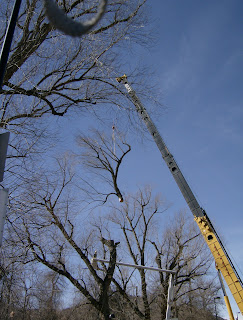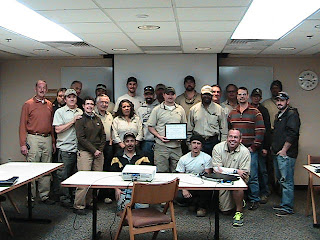Today we recieved our first delivery of Washington Red Ceder mulch. We will use approximately 250 cubic yards of mulch during our preperation for graduation. This delivery was 120 cubic yards and came in loose form on a semi-truck.
We will also receive a shipment of the same mulch but in a compressed pallet form. This is a relatively new delivery method and we have quickly adopted using it. It is a great advantage for us to be able to deliver a pallet of mulch to a large landscape bed and not have to make many trips with our small utility vehicles. This saves fuel and time. In the picture below, one of our staff members is standing on top of the mulch pile. As you can see, it is a daunting task for our staff to manually disperse this amount of product.
We have been using Washington Red Ceder for about 5 years now. We spent a great deal of time back then to work through the best type of mulch for our landscape and our environment. As most of you know, there tends to be some wind here in Boulder and we have to constantly clean up mulch from these wind storms. We initially found a great mulch that held up to the wind very well because it was a very fine shredded mulch. We nicknamed it Gorilla Hair. However the first summer we started using it we ran into an unplanned problem. On hot summer days we started to have very frequent landscape bed fires and after the first few we started to work with the Campus Fire Marshall to help determine the cause. It didn't take long for us to discover that unfinished cigarettes were being discarded into the landscape beds and were causing these fires. The finely shredded material knitted together perfectly to help against the wind, but it was also perfect tinder for fire starting. Once we discovered this problem we had to remove all of that type of mulch on campus and go with our second choice of mulch. Washington Red Ceder has been a good product, even with its higher content of shredded material it still falls victim to wind.
No matter what mulch we use, there are wind storms in Boulder that will move mulch around. The Washington Red Ceder holds its own with normal breezy conditions but we wanted a better way to hold the mulch in the beds. After some research we have started to use a product called Mulch Guard. Think of it as a glue that is applied to the mulch after it has been placed. We do not use this product on all our beds, considering it is pretty expensive and very time consuming to apply. We have been using it on our wind prone areas-where the wind tends to compress and speed up through building corridors and corners of buildings.
It is a constant challenge and a very large amount of work but nothing looks better than a freshly mulched landscape bed:-)
Ryan
Thursday, March 31, 2011
Monday, March 7, 2011
Large Tree Removals on Campus and the Creekpath
Campus users may have noticed the recent removals of several large trees on the main campus and along the creek path north of campus. We took down several Willows and Silver Maples this fall and winter and there will likely be more removals scheduled before summer. Our campus has a large number of these two particular species of trees, many of which have matured to ages of around one hundred years. These are fast growing, very large shade trees which have enhanced the campus' landscape for decades
Unfortunately, these are trees which tend to age rather poorly as they are soft wooded and prone to storm damage. They also are ineffective at resisting decay making them attractive to many forms of animal colonization from bacteria on up to raccoons. Consequently, they often become potentially hazardous in their late years as large branches and trunks become hollowed out by weather erosion and animal nesting. We take all removals of trees on our campus seriously and we make every effort to retain trees as long as is safely possible. We must also practice all precautions aiming to keep our campus users, and their property, safe. The trees we have removed this fall, winter, and spring were moving into an unreasonable threshold for risk on a busy campus and we had to make the decision to remove them.
Our Outdoor Services Department, as well as the department of Planning, Design and Construction, make every effort to plant many trees every spring and fall. This takes place in the form of replacement trees for removals, new trees at new building sites, and Memorial trees donated by campus and community members. We have planted upwards of 100 trees in just the last few growing seasons and we hope to keep up a healthy replacement program for our campus' urban forest for years to come.
The following pictures illustrate some of the deficits in holding material present in some of the trees removed.
The exposed base of this willow shows how little living tissue was left in the lower trunk. The saw is about 8 inches long, the trunks' base was several feet across.
These large stems had significant decay and open cracks were starting to form, creating an unsafe tree.
-Vince Aquino
Friday, March 4, 2011
Outdoor Services Wins Facilities Management Constellation Award
The CU-Boulder Outdoor Services team was recently awarded the Facilites Management Constellation Award. Every month, one team and one individual, are awarded for doing something 'above and beyond' their normal duties. Although the team is used to clearing snow, there were three back-to-back snow storms in the duration of about two weeks. Ryan posted about the challenges this created.
The team was recognized for being timely with addressing the snow storms, sufficiently clearing our streets, sidewalks and stairs, and also clearing some city streets that run adjacent to campus to ensure a safe path for campus constituents.
For most of these storms, this included the crew being on campus at 4 a.m. or earlier, in single degree temperatures, to get everything clear before people started arriving.
Thank you for all of your hard work! Everyone appreciates clear roads and sidewalks that make getting to campus safe and effortless-besides the need to bundle up of course!
Thursday, March 3, 2011
First Install
Well the day has come. After three months of planning and procuring the necessary parts needed to install the compost tea brewers, the first system has been installed. We took a fair amount of time trying to identify all the piping needs, including a way to fill the tanks without having to hold a hose in each tank. The benefit of having these installed in the pump stations is that we can take advantage of the non-chlorinated water that is used to irrigate campus. If we were to use domestic water it would be necessary to go through a de-chlorinization period where you run the blowers and let the chlorine out-gas from the water. This process usually takes 24 hours. If we use our ditch water, we will not have to do this step.
You can see from the picture above they are pretty intricate systems. Our staff did an amazing job with the installation and it turned out looking very clean and professional.
Thanks to everyone who helped support this program through funding and labor!
Ryan
You can see from the picture above they are pretty intricate systems. Our staff did an amazing job with the installation and it turned out looking very clean and professional.
Thanks to everyone who helped support this program through funding and labor!
Ryan
Wednesday, March 2, 2011
Joel E Serafin, OS crew member, earns ISA certification.
Joel Serafin recently demonstrated professional competency by successfully completing the Certified Arborist examination administered by the International Society of Arboriculture (ISA).
The ISA is a scientific and educational organization designed to promote the professional development of those in the field of arboriculture. The ISA Certification Program improves the level of knowledge and standard of practice within the the tree care profession. It is designed to identify those professionals in arboriculture who have demonstrated a thorough knowledge of tree care practices.
Vince
The ISA is a scientific and educational organization designed to promote the professional development of those in the field of arboriculture. The ISA Certification Program improves the level of knowledge and standard of practice within the the tree care profession. It is designed to identify those professionals in arboriculture who have demonstrated a thorough knowledge of tree care practices.
Vince
Tuesday, March 1, 2011
Tree Campus USA
Earlier this week, I learned that the University of Colorado Boulder campus has been certified as a Tree Campus USA for the year 2010 by the National Arbor Day foundation. The Arbor Day society originally began the program of Tree City USA and has more recently developed a category for college campuses. We are the first Front Range campus to achieve this certification and only the second campus in Colorado to do so.
Through much of 2010 a small committee met to pursue this certification. The standards require a five step process and submission of supporting documents.
The first criteria called for the creation of a campus wide committee comprised of Campus Arborists (Facilities Management and Housing), campus students, the Environmental Center, community forestry specialists (from the City of Boulder and Colorado State Forest Service), the Campus Landscape Architect and campus administrators. This group met six times with numerous parts being worked on by individuals, which were then brought back to the commitee discussions.
The second criteria required the details of a campus tree care plan, most of which was in place (particularly in the campus building standards), but in a variety of locations. Vince Aquino, campus arborist, came up with a list of common definitions.
The third standard required the collection of all of our expenses (campus wide) for dedicated tree maintenance items. Over the last few years Outdoor Services have been gathering a few more details about such expenses using our work order management system. Having this detailed information made this step a fairly easy one to complete.
The fourth standard was a 'celebration' event for Arbor Day. Since mid April had already past when out committee got rolling, we added a tree planting component to a Tree Walk that occured in October with a group of Fourth graders from Flatirons Elementary school to meet this requirement. Going forward we will be aiming to celebrate Arbor Day in mid-April. Watch this blog for more information regarding this year's event to be posted closer to April.
The fifth standard is aimed at 'service learning project' engaging campus students in participation in the campus tree care program. Vince Aquino provided leadership for a group of students on a Russian Olive (indentified as a noxious, invasive species) mitigation prject at the South Campus property to meet the requirements of this standard. Vince had done a post about this project a month ago on this blog.
Going forward, the committee will be working on continuing efforts in each of the five core areas throughout 2011 with the goal of maintaining our 'certified' status. We have a few more ambitious goals (that may take longer than a year to complete) such as getting the campus-or at least a portion of it-established as an Arboretum and the development of a detailed campus tree inventory.
Alan
Subscribe to:
Comments (Atom)











